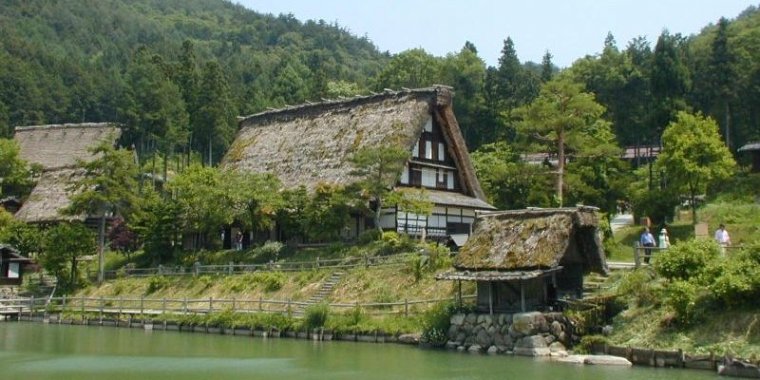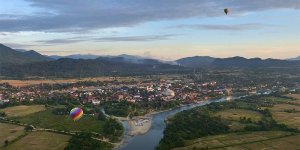| Published in Destinations |
Takayama, Japan

Houses in the Hida-no-Sato open-air museum. ![]()
Takayama, sometimes called Hida-Takayama, is a city near the northern Japan Alps of Gifu prefecture, in the Chubu region of Japan. The name 'Takayama' means 'tall mountain'.
Much of the city had been established when it had been a castle town surrounding the Takayama Castle since the 15th century until the 18th century. The central Tokugawa shogunate then took over the control and demolished the castle.
Over the period of some 200 years since then, the city saw development of the forestry industry and boasted the crafts made by its artisans. The art of woodcraft and other works of craftsmanship has then been passed over through the Meiji era to the present day.
Having a humid continental climate, there is a large variation in temperature in the city in summer, sometimes from 0 to 35 degrees in a day. With much of the area close to or midst of mountains, winter brings constant snowfalls to the city, with temperatures sometimes falling below -10 degrees.
Tourist office
Hida Tourist Information Office Hida Hotel Plaza Takayama, 1-1 Showa-machi (Right in front of JR Takayama Station), +81 577-32-5328, e-mail: kankou@hida.jp. The staff speak English and are a mine of information for the area. Open daily from 8.30 AM to 5 PM.
Get in
Takayama is the major transport hub of the Hida region.
By train
Hida-Takayama's train station, Takayama, is located on the JR Takayama Line.
From Tokyo Station, you can reach Takayama by taking a Tokaido Shinkansen train (Nozomi or Hikari) to Nagoya and then transfer to the Wide View Hida Limited Express train for the run to Takayama. The ride takes just over 4 hours via Nozomi with a good connection, and costs ¥14800. By Hikari it takes 4 1/2 hours, but the ride is fully included in the Japan Rail Pass. From Kyoto or Osaka, you can take the Shinkansen to Nagoya, then the Wide View Hida, but there is also a morning Wide View direct from Osaka and Kyoto, slightly slower but more convenient.
With the opening of the Hokuriku extension of the Nagano shinkansen to Kanazawa, it is now also possible to take it from Tokyo or Ueno as far as Toyama (all-reserved Kagayaki or just slightly slower Hakutaka, at least hourly, travel time 2 1/2 hours, both included in the JR Pass), and transfer to one of the 4 daily runs of the Wide View Hida express that originate from there instead of Takayama (travel time about 1 1/2 hours). Local trains on the JR Takayama line between Toyama and Takayama take about 2 hours, with a transfer at Inotani.
Another option is to travel from Shinjuku in Tokyo to Matsumoto on the Azusa/Super Azusa limited express train, then walk to Nohi Bus at the Matsumoto Bus Terminal and travel by express bus to Takayama. Holders of the JR East Rail Pass can use the Azusa at no charge and are eligible to purchase a round trip bus ticket between Matsumoto and Takayama at the discounted charge of ¥2500 (normally ¥5500).
The trip takes approximately 5 1/2 hours each way depending on connections in Matsumoto. The downside is that you can only buy these tickets at the JR East Travel Service Centers at Narita or Haneda Airports, or in Takayama at the Nohi Bus Center. Those with a JR East Pass that are already in Tokyo will need to take the Tokyo Monorail to Haneda Airport (free with the pass) and visit the JR East counter during business hours to purchase this bus ticket.
By bus
From Chubu Centrair International Airport, Nohi Bus provides a bus service for ¥4000. The 3.5 hour trip requires a transfer in Meitetsu bus center in the Nagoya train station.
Nohi Bus runs highway buses from Tokyo (5.5h, ¥6690, jointly with Keio Kosoku Bus, great views along the way), Nagoya, Gifu, Kyoto, Osaka, Kanazawa, Shirakawa-go, Toyama, Matsumoto and mount Fuji.
Buses to and from the Oku-Hida Onsen Villages leave from the bus station adjacent to JR Takayama station.
If you go the mountain route, there is a bus from Matsumoto (with some mountain village like Kamikochi on the way).
Get around
Takayama is small enough to cover on foot, but bicycle rental (¥600 per day from the youth hostel) is also a good option.
What to See in Takayama
• Hida Folk Village ('Hida Minzokumura' also known as Hida-no-Sato). An attractive open-air museum assembled from real buildings that effectively recreates an entire traditional mountain village. Not only can you tour the village, but artisans continue to work in many buildings; you can buy their crafts and even try your own hand at a number of activities.
The architectural highlights are the traditional thatched-roof gasshō-zukuri houses, built with roofs like hands in prayer to withstand the heavy snowfalls in this region. More whimsically, there is a giant maneki-neko cat outside, standing over 4m tall. Entry is ¥700, or ¥930 for a combination ticket including bus transfers from and to JR Takayama station (recommended, as this will save you a 30-minute uphill walk).
• Karakuri Museum, 506-0858 Gifu Prefecture. 9AM-4:30PM. Museum displays mechanical dolls which get mounted onto the Takayama festival floats. The museum also shows over 200 lion dance masks from around Japan.
• Kusakabe Mingei-kan (Kusakabe Heritage House), 1-52 Ojin-machi Takayama-shi, Gifu 506-0851, +81 577-32-0072. The Kusakabe house is a restored old merchant's home built in 1879. The home is filled with artifacts and crafts from that time period.
• Matsuri no Mori, 5 Chome-1 Tenmanmachi, Takayama, Gifu Prefecture 506-0025, +81 577-32-5100. 9AM-5PM. Literally "Festival Forest," Matsuri no Mori displays floats and other key items from the Takayama Festival. Similar to the Takayama Float Museum but larger. Also contains large taiko drums and hosts performances. Museum is roughly a 15 minute bus ride south of the city center.
• Sakurayama Nikkokan, 506-0858 Gifu Prefecture. 9AM-4:30PM. Admission is included in the ticket to the Takayama Festival Float Museum. The hall displays one-tenth-scale replicas of 28 buildings from Nikko's Toshogu shrine, created by craftsmen in intricate detail.
• Sanmachi. It is a very pretty section of Takayama's old city. Consisting of three narrow lanes packed with wooden buildings housing sake breweries and little boutiques, some of the larger merchant houses are now open as museums. The area, though it is definitely worth a visit, is quite touristy now and you will find many "Gaijin" along with Japanese tourists around browsing the lanes flanked by tourist-oriented shops. The area is a 10-minute walk to the east of the station.
• Takayama Jinya. It is a large, beautifully preserved government building from the time of the shogun and still used as local government building until 1969. Many rooms at the beginning of the visit are basically empty (but this is not a strange thing in Japan where rooms are usually scarcely populated by furniture) tatami rooms with the indication of what was done in the room or who would work or live there.
The visit becomes increasingly interesting the further you proceed, since in the rice storage area there are interesting displays and information (unfortunately mostly in Japanese, but there are some panels in English) about the way the local government of Japan worked in the Edo era. The (two) storage buildings alone, the biggest such original buildings still present in Japan, are worth the visit. adults 420 ¥.
• Takayama Museum of History and Art, Hidatakayama-machi no Hakubutsukan). 9AM-7PM. Located in 17th century warehouses once owned by the Yajima family who ran a timber business and the Nagata family who owned the best sake breweries in Takayama. There are 14 exhibition rooms dedicated to individual themes ranging from the Takayama Festival and traditional houses to the city’s history and local artists. free.
• Takayama Yatai Kaikan, 178 Sakura-Machi, Takayama City, +81 577-32-5100. 9AM-4:30PM. Takayama Festival Float Exhibition Hall. This is the hall where the festival floats are stored. Takayama hosts a famous yearly festival and the floats are quite ornate. The floats on display are rotated.
What to Do in Takayama
Takayama is famous for its two festivals:
• Sannō Matsuri, April 14-15 and Yahata Matsuri, October 9-10. Even though the festivals' origin is unknown, it is said that they were first celebrated between 1586 and 1692 when the Kanamori family governed the Hida Takayama area. The spring festival is associated with Hie Shrine and the autumn with Sakurayama Hachimangu Shrine. Both are much alike and feature a parade of large floats decorated with thick curtains, lacquer ware, and mechanical dolls (karakuri).
Twelve floats appear in the spring festival and eleven in autumn. The procession carrying the portable shrine (mikoshi) is unique to the autumn. During both festivals, this usually quiet town is lively and filled with visitors, so it is best to book accommodation (particularly on the night of the parade) and tickets early.
• Higashiyama Walking Course. A 3.5 kilometer long hiking trail through Takayama's temples and shrines, past some some of its more rural neighborhoods, and through Shiroyama Park, the former site of Takayama Castle. The course starts and ends at the Takayama Museum of History and Art.
• Miyagawa Morning Market. 7AM (8AM in winter months) to mid morning. Local vendors set up stands along the Miyagawa River each morning to sell their wares, ranging from crafts and handmade items to produce, flowers, and snacks.
• Miyagawa Ryokuchi Park. A long, simple park along the Miyagawa River which peaceful views of the water. A great spot for cherry blossom viewing in the spring as the park is lined with over 100 cherry trees.
Buy
• Sarubobo amulets. (lit. "baby monkey") Shaped like faceless humans and available in a variety of sizes, are the most popular souvenir from Takayama.
• Shunkei lacquerware. Beautiful wooden boxes, trays and utensils, with a lustrous transparent lacquer that lets the grain of the wood show through.
• Wood Block Prints. Takayama is known for its wood block prints, with many well known artists spending time each year in Takayama. Many shops sell original modern works at reasonable prices.
• Hida Sashiko. All hand-made, beautiful stitching goods are displayed as if gallery. All of the arts and goods are purchasable. Media often report Hida-Sashiko as Japanese traditional art with the beauty of goods and its skills.
Eat
Takayama is famous for its ramen noodles, cooked in miso stock with thin noodles. As elsewhere in Gifu, you are also likely to encounter hōba miso, a version of the ubiquitous Japanese bean paste grilled on a hōba leaf and served as a dip or for eating with rice as is. Sounds pretty simple, but the taste is exquisite. Takayama is also famous for its steak (hidagyu). You can find it at many restaurants throughout the city.
• Agura, 4-7 Shinmeicho (On the road that runs to the south of Takayama City Memorial Hall, on the right side (look for the green sign with the yellow seated Buddha; 12 min.)), +81 577-37-2666. Tue-Sun 6pm-midnight. An excellent restaurant in Takayama built out of an old warehouse, Agura serves Western-style pizza and a variety of other Japanese and vegetarian friendly fare. A good place to go if you need "something for everyone". Hours are a little odd, dinner only. Prices are moderate, ranging from ¥800-¥1,500. They do accept credit cards.
• Beef Bun and Cafe Kihachiro Kamisannomachi, 35 Kamininomachi, Takayama 506-0845, +81 577-62-8811. A great stop for lunch or a quick snack, this small shop in the middle of Sannomachi is most well known for its beef buns. They also serve small lunch type food, such as sakura pudding, tea, and beer.
• Chitose, 6-19 Hanasatomachi, Takayama, +81 577-32-1056. A casual restaurant specializing in yakisoba, a dish made from fried soba noodles. English menu available.
• Crepe and Wine Hanchikutei, 1-95 Hachikenmachi, +81 577-37-7817. Arguably the best desert shop in Takayama, this tiny crepe and wine store has amazing treats and the owners are super friendly! It's still open later in the evening when many of the surrounding shops are closed.
• Hatoya, 3-110 Oshinmachi, Takayama, +81 577-32-0255. Traditional Japanese restaurant specializing in Hida beef. They are especially known for their sukiyaki, which is hot pot cooked beef dipped into raw egg and eaten. A pricey splurge but totally worth it! Group plans available.
• Maruaki, 6-8 Tenmanmachi, Takayama 506-0025, +81 577-35-5858. Traditional Japanese restaurant with reasonably priced Hida beef. English menu available, friendly staff, grill and hot pot options.
• Sakaguchiya, 90 Kami-sannomachi, +81 577-32-0244. Traditional Japanese restaurant located on the main sannomachi street. The menu has local soba and miso dishes. They have excellent hōba miso steak. You get a large piece of beef which is of high quality. Good value for money. This place is popular among Japanese tourists.
Drink
Takayama is pretty quiet at night. Some of the few bars which are open include:
• Desolation Row, 30 Asahimachi, Takayama. Cozy cellar whiskey bar with plenty of vinyl records from the 60s through the 1990s. Owner knows a lot about music.
• Japanese Pub Yu, 1-3-1 Hatsudamachi, Takayama, +81 577-54-1093. Open 4PM-11PM. Closed Sundays.. Yuichi Sano, the owner, is very friendly and welcoming. Great cocktails, even better conversation.
• Red Hill Pub, 2-4-2 Sowamachi, Takayama, +81 577338139. Open 7PM-midnight. Closed Mondays.. Stocks imported beer as well as serving the usual cocktails and liqueurs. Light food such as pasta, salads, snacks, etc available. The proprietress, Hisayo, speaks fairly good English. Expect to pay ¥600-¥800 for drinks. Popular with local foreigners.
• Rum Dance Hall, 29 Asahimachi, Takayama. A lot of different shochu and rum. Owner speaks English; good place to finish after "Doya." Best to ask your way from Doya; the Rum dance hall is very close.
Sleep
Takayama has more traditional-style accommodations than western-style hotels, but it is a great opportunity to experience a ryokan or temple stay. Keep in mind that in Japan, room rates are advertised as per person as opposed to per room. Accommodations are categorized below with the assumption two adults would be staying in the room.
Budget
• Hida Takayama Tenshōji, 83 Tenshojimachi, Takayama, +81 577-32-6345. Check-in: 3PM-9PM, check-out: 6AM-10AM. A temple-affiliated youth hostel on the eastern outskirts of the city, a 20-minute walk from the station. A bed for the night is ¥3400/night for HI members and ¥3700/night for non HI members.
• J-Hoppers Hida Takayama Guest House, 5-52 Nadamachi, Takayama (3 min walk from JR Takayama Sta. Just in front of Takayama Post Office), +81-577-32-3278. Check-in: 15:00, check-out: 11:00. The first independent hostel in the Hida region. Roomy bunk beds in dormitories and some Japanese style private rooms. The place itself is nice but they advertise themselves to Japanese as a place to learn and practice English, so expect constant pestering for free lessons. Self catering kitchen, hot shower, Free Wi-Fi, Guest PC, Rental bikes, Free tea/coffee. Credit cards accepted (Visa/MasterCard) Dorm from 2500 yen, twin/double 3000 yen/pp.
Mid-range
• Temple Hotel Zenkoji, 4-3 Tenmancho (Exit station, turn right, walk until 2nd light. Turn left, walk until 3rd light), +81-577-32-8470. Clean, spacious rooms, no meals but has kitchen and owner speaks very good English. 3 rooms for 3, 5 and 9 pers. starting from ¥25000, ¥20000 and ¥4000 in low season, up to +50% in high season, +¥3000/person if more that 2/2/4 guests.
• Best Western Takayama, 6-6 Hanasatocho, +81 577-506-0026. Western-style hotel with free WIFI, business center, room service, restaurant, and spa. Close to Takayama station.
• Takayama Green Hotel, 2-180, Nishinoisshikimachi, Takayama City, +81 577-33-4600. Japanese and western style rooms and breakfast buffet. Amenities include onsen, fitness center, karaoke room, free parking and WIFI. About a ten minute walk to downtown, with bicycles available to rent.
Splurge
• Hida Hotel Plaza Takayama, 60 Hanaoka-cho 2-chome,Takayama, +81-577-33-5500. Both Western and Japanese style rooms available with meal plans in this modern hotel which is a 15 minute walk from most tourist locations. Free WiFi connection available in public spaces as well as six dining options, hot spring facilities, and a heated swimming pool.
• Oyado Koto No Yume, 6 Chome-9 Hanasatomachi, Takayama, +81 577-32-0427. A romantic ryokan located close to Takayama Station and within walking distance of Old Town. Hotel features indoor/outdoor onsen, private full bathrooms, free yukata rental, free WIFI, and an English-speaking staff. Included dining plans available.
• Yamakyu, 58 Tenshojimachi, Takayama, +81 577-32-3756. Japanese style ryokan located near the Higashiyama Walking Course and temples. Ryokan is about a 20 minute walk from Takayama station, but offers free shuttle service to and from the station if you ask a day ahead. Ryokan includes a public onsen, but private bathrooms do not include bathing/showering facilities. Included dining plans available.
Go next
• The remote and beautiful Oku-Hida Onsen Villages are less than an hour away by bus.
• Shirakawa-go, with its beautifully preserved villages and open-air museum, is memorable. Stay in one of the old-time farmhouses. Reached by a 2-hour scenic bus ride (a new road has been built and the bus ride takes one hour only now, but no longer scenic) from Takayama.
• Gero Onsen, one of Japan's three famous hot-springs, is just a short ride away down the JR Takayama line. (Wikivoyage)
See also Takayama in Pictures
YOU MAY ALSO LIKE






 If you own or manage a travel-related business such as a hotel, a bed-and-breakfast, a restaurant, a pub or a cafeteria, you can create a web page for your business for free on Titi Tudorancea Travel Info. » |